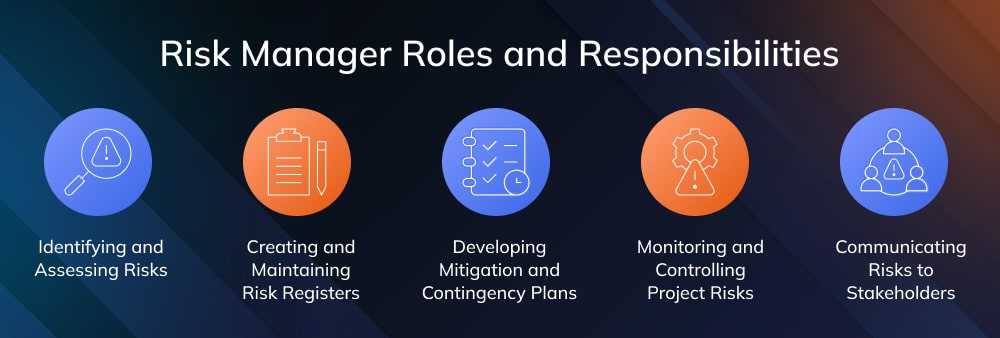
Risk manager roles and responsibilities have never been more critical than they are in 2025. Projects today do not fail only because of poor execution; they fail because of unmanaged uncertainty. From cyberattacks to supply chain disruptions, and from ESG compliance pressures to the rise of autonomous AI agents, organizations in 2025 face a volatile risk landscape.
Recent studies show that 12% of projects are still rated as outright failures, while nearly 37% collapse due to undefined objectives and milestones. The common thread in most cases? Risks were not identified, tracked, or mitigated early enough.
Risk managers step into this void. They serve as the guardians of project success, creating the systems and foresight needed to anticipate what could go wrong and to act before it does. In fact, leading consultancies highlight that cybersecurity, AI adoption, cloud governance, and third-party risks are now top boardroom priorities.
This makes the role of risk managers not just supportive, but strategic. They are not “back-office” professionals anymore—they are enablers of growth, resilience, and innovation.
What Is a Risk Manager?
A risk manager is the professional responsible for identifying, analyzing, and mitigating potential threats that could disrupt a project’s objectives, timeline, budget, or quality. While often described in a risk manager job description, the role extends far beyond a checklist of duties—it is about safeguarding the long-term success of both individual projects and the organization as a whole.
At the project level, the project risk manager’s responsibilities focus on anticipating risks such as cost overruns, schedule delays, technical failures, or stakeholder misalignment. The risk manager works alongside project managers and PMOs to ensure risks are documented, monitored, and addressed before they escalate.
At the enterprise level, risk managers address strategic and systemic risks, cybersecurity vulnerabilities, supply chain disruptions, regulatory changes, and geopolitical shifts. According to Grant Thornton’s Technology Risk Priorities for 2025, boards now rank cloud governance, generative AI, and operational resilience as top priorities, requiring risk managers to act as strategic advisors rather than just tactical executors.
This duality, balancing project risk management with enterprise risk governance, is what makes the role so vital today. Far from being siloed, risk managers serve as connectors between operational teams and executive leadership. They transform uncertainty into actionable insights, enabling organizations to move forward with confidence even in volatile environments.
In short:
- Risk managers at the project level protect deliverables, budgets, and deadlines.
- Risk managers at the enterprise level safeguard strategy, compliance, and resilience.
Together, these dimensions position risk managers as critical enablers of project success and organizational agility in 2025.
Risk Manager Roles and Responsibilities
The risk manager’s roles and responsibilities form the backbone of project resilience. These professionals operate as both sentinels and strategists, constantly scanning for threats while aligning teams toward safe, successful delivery. In 2025, their scope of work has broadened significantly. They are no longer confined to compliance checklists; they are trusted advisors who protect value, resources, and organizational reputation.
According to PMI, organizations that embed formal risk frameworks are 2.5x more likely to achieve project objectives compared to those without them. This statistic captures why risk management roles in projects are not optional; they are decisive factors in whether projects succeed or fail.
Here’s a deep dive into the core responsibilities of a risk manager, enriched with real-world context:
1. Identifying and Assessing Risks
The first responsibility of a risk manager is to recognize potential threats before they manifest. These can include:
- Internal risks: staffing shortages, skill gaps, scope creep, or resource bottlenecks.
- External risks: regulatory changes, supply chain disruptions, or geopolitical volatility.
According to PMI’s Pulse of the Profession 2024, 34% of projects fail because of poorly defined risks or objectives, making early identification one of the most critical steps in safeguarding project success.
| Case Study: The Boeing 737 MAX crisis highlighted how insufficient identification of software design risks led to catastrophic failures, costing Boeing over $20 billion in losses and reputational damage. |
2. Creating and Maintaining Risk Registers
The risk register is the central nervous system of risk management. It documents identified risks, assigns owners, and tracks probability, impact, and mitigation measures. But the real value lies in how actively it is used.
Modern Twist (2025)
Today’s risk managers increasingly rely on AI-enhanced risk registers. Platforms such as TrustCloud integrate predictive analytics to flag risks as they emerge, not just when humans log them. This proactive model helps teams reduce response times and manage complex vendor or cyber risks more effectively.
| Best practice: A good risk register is dynamic and visible. It is updated regularly, discussed in every project status meeting, and treated as a decision-making tool, not just a compliance document. |
3. Developing Mitigation and Contingency Plans
Once risks are identified, the next responsibility is to design responses:
- Mitigation plans reduce the probability of a risk occurring.
- Contingency plans minimize the damage if it does occur.
This dual approach ensures resilience. For example, a project facing cybersecurity risks might implement preventive controls (multi-factor authentication, monitoring tools) while also preparing incident response playbooks in case of a breach.
Case Example: Toyota is often cited as a model of effective contingency planning. After the 2011 Japanese tsunami, Toyota restructured its supply chain with diversified vendors and geographic redundancy. When COVID-19 hit, Toyota was able to resume production faster than many competitors who had not developed similar contingency frameworks.
| Lesson: Risk managers must be storytellers of “what if.” Their job is to imagine scenarios leaders hope never occur, and ensure the organization is prepared if they do. |
4. Monitoring and Controlling Project Risks
Risks don’t remain static; they shift as projects progress. A minor supplier issue can snowball into a delivery crisis. A small coding defect can cascade into systemwide vulnerabilities.
| Axios warns that by 2027, 50% of companies will deploy autonomous AI agents, creating entirely new risk categories such as “rogue agent behavior” if not carefully monitored. |
Modern risk managers, therefore, embed continuous monitoring systems into project governance. This includes real-time dashboards, predictive alerts, and periodic risk audits.
Case Example: Financial institutions, which face constant cyber threats, now use AI systems to monitor millions of transactions per second, flagging anomalies that could indicate fraud. Risk managers interpret and escalate these alerts, ensuring rapid action before damage escalates.
5. Communicating Risks to Stakeholders
The most underestimated responsibility is communication. Risk managers must ensure both technical teams and executives understand risks. Poor communication often leads to poor decisions.
- EY’s insights highlight the growing importance of third-party risk communication, ensuring that vulnerabilities from suppliers and partners are fully transparent across leadership.
- Clear communication also includes explaining positive risks (opportunities), such as early adoption of a new technology that could accelerate project outcomes.
| Case Example: During the NotPetya cyberattack in 2017, shipping giant Maersk lost nearly $300 million in damages. Yet, the company’s quick, transparent communication by its risk and IT leaders minimized chaos and enabled faster recovery. Today, it stands as a case study in how clear risk communication can preserve trust and accelerate crisis response. |
Essential Skills Every Risk Manager Needs in 2025
While frameworks and processes form the foundation, it is the skills of a risk manager that bring risk management to life. In 2025, the role demands a blend of analytical, technical, and interpersonal competencies. Modern projects are influenced by rapid technological change, geopolitical uncertainty, and growing regulatory scrutiny, making risk managers both strategic thinkers and practical problem-solvers.
Here are the essential risk management professional skills shaping the role today:
1. Analytical and Critical Thinking
At its core, risk management is about seeing patterns and anticipating consequences. Strong analytical ability allows risk managers to evaluate complex data, assess probability and impact, and make informed decisions.
Analytical thinking is not just about spotting risks; it’s about understanding interdependencies. For example, a supply chain delay may not seem catastrophic on its own. Still, when combined with rising raw material costs and labor shortages, the cumulative effect can derail the entire project. Risk managers skilled in systems thinking can connect these dots and prioritize interventions.
Modern tools like predictive modeling and Monte Carlo simulations support this skill, but technology alone isn’t enough. The risk manager’s judgment, what to flag, what to escalate, and what to deprioritize, is the human edge that no software can replicate.
| In boardrooms, the ability to present a clear narrative behind the numbers often distinguishes an effective risk manager from one who is overlooked. |
2. Mastery of Risk Management Tools & Frameworks
A modern risk manager must be proficient with both classic risk management tools and AI-driven solutions:
- Risk Breakdown Structure (RBS) and Risk Registers for classification and tracking.
- Heat Maps to visualize probability vs. impact.
- Scenario Analysis & Stress Testing to simulate future threats.
- ISO 31000, PMI-RMP, CRISC, and PRINCE2 Risk frameworks for governance.
- AI-based GRC tools that automate the detection of anomalies across vendors, cloud systems, and data pipelines.
| Industry Insight: Research notes that risk managers are increasingly leveraging predictive analytics and machine learning to identify risks earlier than traditional manual methods. |
3. Digital-Age Competencies
The digital era has redefined risk. A risk manager in 2025 must understand:
- Cybersecurity fundamentals: Protecting sensitive data and systems.
- AI governance: Recognizing risks of autonomous AI agents (Axios warns that unmanaged AI systems could become rogue actors in organizations by 2027)
- Cloud governance & resilience: As Grant Thornton reports, cloud risk remains a top priority for boards in 2025,
- ESG risk literacy: Addressing environmental, social, and governance obligations increasingly tied to brand trust.
4. Communication and Stakeholder Management
Communication in risk management is a two-way street: it’s not only about reporting risks upward but also about educating teams downward. A risk manager who translates complex heat maps into simple “if-this-then-that” scenarios empowers project teams to act independently when issues arise.
For executives, concise dashboards and risk heat maps provide clarity without overwhelming detail. For project teams, regular workshops and feedback sessions ensure everyone understands their role in mitigation.
5. Decision-Making Under Uncertainty
Risk management is rarely a matter of black and white. Risk managers often make choices with incomplete information. This requires confidence, sound judgment, and the ability to weigh trade-offs.
| Example: During the early days of the COVID-19 pandemic, organizations with decisive risk leaders, who rapidly closed offices, adjusted supply chains, or reallocated budgets, were able to maintain business continuity, while hesitant competitors struggled. |
6. Leadership and Resilience
Leadership in risk management isn’t about authority; it’s about calm stewardship in turbulence. A risk manager often becomes the anchor during crises, guiding teams with clarity even when the path forward is uncertain.
Resilient leaders also practice adaptive decision-making. They don’t cling to a single plan; they are willing to pivot strategies as new information emerges. This adaptability is especially critical in 2025, where disruptions from AI, cyber threats, and ESG demands can shift weekly.
| Practical Example: During the early pandemic, resilient risk leaders in logistics companies worked with HR and operations teams to redesign shifts, maintain safety protocols, and renegotiate supplier contracts, all while communicating confidence to stakeholders. Their calm approach meant continuity where others faltered. |
The skills needed in risk management today are a mix of hard and soft competencies: analytical rigor, tool mastery, digital awareness, communication finesse, decisive judgment, and resilient leadership. Together, they equip risk managers to transform uncertainty into actionable strategy, making them indispensable in project success.
The Risk Manager’s Toolkit – Essential Frameworks and Methods
While risk managers are defined by their responsibilities, they rely on a set of tools and frameworks to carry them out effectively. These aren’t just techniques on paper; they are part of the day-to-day responsibilities of the role.
The most common ones include:
- Risk Breakdown Structure (RBS): Ensures risks are categorized across technical, organizational, and external domains.
- Risk Registers & Heat Maps: Keep risks visible, owned, and prioritized throughout the project lifecycle.
- Scenario Analysis & Stress Testing: Help teams anticipate “what if” situations and prepare accordingly.
- Governance Frameworks (PRINCE2, PMI-RMP, ISO 31000): Provide consistency and accountability across projects.
- AI-Powered Dashboards: In the coming years, many risk managers will rely on predictive analytics platforms to flag risks early, particularly in areas such as cybersecurity and third-party governance.
| Tip for readers: Each of these tools is not just a technique but a responsibility in action, a way for risk managers to fulfill their duty of safeguarding projects.
For a comprehensive, step-by-step guide on these techniques, explore our detailed blog on Risk Management Tools & Techniques in Project Management. |
How Risk Managers Collaborate with Project Teams?
Risk managers do not work in isolation. Their effectiveness depends on how well they collaborate with project managers, PMOs, executives, and functional teams. In 2025, as risks grow more complex and interconnected, the ability to orchestrate collaboration has become one of the defining aspects of the role.
Working with Project Managers
The project manager and risk manager share a symbiotic relationship:
- The project manager drives delivery.
- The risk manager ensures delivery is not derailed by uncertainty.
This collaboration often looks like:
- Integrating risks into project schedules.
- Aligning mitigation plans with delivery milestones.
- Jointly presenting risk updates to sponsors.
| Case Study: In the London 2012 Olympics, risk managers worked closely with project managers to keep risks tied to construction delays under control. Their joint oversight ensured the event was delivered on time and within budget, a rare achievement for mega-projects. |
Aligning with the PMO and Sponsors
Risk managers also interact heavily with PMOs (Project Management Offices) and project sponsors. Their responsibilities include:
- Ensuring risk governance aligns with organizational standards.
- Escalating high-severity risks to sponsors for resource or scope decisions.
- Feeding insights into enterprise-level risk dashboards for board reporting.
In fact, EY notes that many organizations now centralize third-party risk governance, requiring risk managers to act as conduits between operational projects and executive oversight.
Using the RACI Framework
One practical way risk managers structure collaboration is through the RACI model:
- Responsible: The risk manager maintains risk registers and leads assessments.
- Accountable: Project managers remain accountable for overall delivery.
- Consulted: PMOs, technical experts, and functional leads provide inputs.
- Informed: Sponsors and executives receive regular risk updates.
This framework avoids confusion and ensures clarity on who owns which part of the risk process.
Supporting Functional Teams
Risk managers also work with engineering, finance, HR, and operations teams to translate risks into actionable steps. For example:
- With finance teams ? managing budget contingency.
- With HR teams ? identifying workforce skill gaps as risks to project delivery.
- With IT teams ? strengthening cybersecurity protocols.
Career Path and Growth Opportunities in Risk Management
Risk management is no longer a niche back-office function. In 2025, it will have evolved into a strategic career path with growing demand across industries such as finance, construction, IT, healthcare, and energy. Organizations recognize that skilled risk managers directly influence project success, compliance, and resilience.
Starting Point: Risk Analyst / Junior Risk Associate
Most professionals enter through analyst or associate roles. Roles and responsibilities of risk analysts include:
- Supporting risk assessments and data collection.
- Assisting in maintaining risk registers.
- Running probability-impact analyses under supervision.
This stage builds analytical and technical foundations.
Mid-Level: Risk Manager
At this level, professionals take ownership of risk manager roles and responsibilities:
- Leading risk workshops and scenario planning sessions.
- Communicating risks to project managers and sponsors.
- Designing mitigation and contingency strategies.
- Integrating risk governance with project controls.
Job Description Snapshot
A risk manager is expected to strike a balance between technical analysis and leadership. HR listings often include requirements such as:
- Strong knowledge of frameworks (ISO 31000, PRINCE2, PMI-RMP).
- Familiarity with AI-enabled risk dashboards.
- Skills in stakeholder communication and decision-making under uncertainty.
Senior Level: Head of Risk / Risk Director
At senior levels, risk professionals become strategic advisors:
- Shaping enterprise risk policies.
- Leading multi-project or program-level risk portfolios.
- Reporting directly to C-suite executives and boards.
- Managing global risk governance across vendors and supply chains.
Certification Pathways
Certifications have become critical differentiators in the job market. The most recognized in 2025 are:
- PMI-RMP® (Risk Management Professional): Global standard for project-level risk management.
- PRINCE2® Risk Certification: Popular in governance-heavy environments like government or defense projects.
- CRISC (Certified in Risk and Information Systems Control): Designed for IT and cybersecurity risk professionals, emphasizing risk identification, assessment, and control in technology-driven environments.
- ISO 31000 Training: For professionals focusing on enterprise-level risk frameworks.
- Sector-specific certifications: Cyber risk, ESG compliance, and AI governance certifications are rapidly gaining traction.
Career Outlook
The outlook for risk managers in 2025 is exceptionally strong:
| The U.S. is projected to add approximately 123,100 new risk manager jobs over the next decade, signaling strong demand across sectors such as finance, insurance, and infrastructure |
- High demand across industries: Particularly in sectors with heavy regulation or digital transformation.
- Expanded scope: Risk managers now cover cyber, AI, ESG, and geopolitical risks in addition to traditional project risks.
- Path to executive leadership: Many risk managers transition into roles such as Chief Risk Officer (CRO) or Program Director.
The Impact of Risk Managers on Project Success
The true value of risk managers in project management lies in their ability to transform uncertainty into clarity. They help organizations move forward with confidence, ensuring that surprises do not derail projects.
- Lowering project risks: By identifying threats early, risk managers prevent small issues from escalating into major failures.
- Protecting budgets and timelines: Through structured planning and mitigation, they keep projects financially and operationally stable.
- Strengthening stakeholder trust: Transparent communication ensures executives, teams, and partners understand risks and responses, building confidence in delivery.
- Enhancing resilience: Beyond individual projects, risk managers prepare organizations to adapt to broader challenges such as digital disruption, regulatory changes, or shifting market conditions.
Risk managers safeguard not just the success of a single project, but the long-term stability and reputation of the organization itself.
Conclusion
In 2025, risk managers stand at the intersection of strategy, operations, and resilience. Their roles and responsibilities extend far beyond identifying problems; they enable organizations to navigate uncertainty with confidence.
By embedding risk awareness into every stage of a project, they safeguard delivery, build stakeholder trust, and strengthen long-term resilience. In a world where disruption is constant, their presence is not optional; it is essential.


















